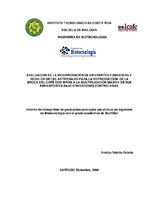Evaluación de la incorporación de diferentes fungicidas y dosis en dietas artificiales para la reproducción de la broca del café con miras a la multiplicación masiva de sus parasitoides bajo condiciones controladas
Resumen
La broca del café, Hypothenemus hampei (Ferrari) (Coleoptera: Scolytinae), es el
insecto plaga más importante entre los que afectan la caficultura en todo el mundo.
Existen diversas formas de controlar esta plaga, entre estas, el control biológico con
parasitoides. Entre los más importantes se pueden citar tres géneros de avispitas:
Cephalonomia stephanoderis, Prorops nasuta y Phymastichus coffea, que pueden
ser reproducidos en grandes cantidades y utilizados como herramienta de control.
En Costa Rica, en el Centro de Investigaciones en Café, CICAFE, se han realizado
intentos de cría de estos parasitoides sobre café pergamino, sin embargo, esta
metodología es costosa y lenta. Debido a esto, la tendencia actual va hacia el
desarrollo de dietas artificiales que permitan la producción de la broca y sus
parasitoides a gran escala y a bajo costo. En el CICAFE, se ha logrado desarrollar
un medio de cultivo para la broca y sus parasitoides, sin embargo, este presenta
altas tasas de contaminación por hongos, lo que merma la producción de las brocas
y por consiguiente, de los parasitoides, haciendo al proceso poco viable. Por esta
razón, el objetivo de esta investigación es evaluar la incorporación de diferentes
fungicidas y dosis en dietas artificiales para el desarrollo y reproducción de la broca
del café bajo condiciones controladas, para así lograr disminuir la contaminación por
hongos en la dieta. Con este fin, se aislaron los hongos contaminantes de la dieta,
obteniendo a Aspergillus sp., Penicillium sp., y Fusarium sp. como hongos
predominantes. Pruebas de sensibilidad a seis fungicidas se realizaron con estos
tres hongos, determinando que el Butrol 31.5 EC era el más eficiente para inhibir el
crecimiento de los mismos. Este fungicida fue probado en la dieta artificial y
comparado con dos controles (Benlate 50 WP y Daconil 82.5 WG) donde demostró
de nuevo su efectividad superior para evitar el crecimiento de los hongos, así como
para permitir un mejor desarrollo del ciclo de vida de la broca, traducido en una
mayor producción de progenie. El Butrol 31.5 EC también fue probado como
desinfectante directo en el lavado de las brocas comparándolo con los controles
anteriormente mencionados, así como probando la adición de un surfactante a la
solución de lavado. De nuevo, el Butrol 31.5 EC produjo los mejores resultados en
cuanto a contaminación y sobrevivencia de las brocas, no obstante se observó que
la incorporación de un surfactante fue perjudicial para las brocas. Se concluyó que
el Butrol 31,5 EC fue el fungicida más adecuado para utilizar en las dietas, aunque
podría probarse a concentraciones más altas que las utilizadas en esta
investigación, para mejorar los resultados. The coffee berry borer, Hypothenemus hampei (Ferrari) (Coleoptera: Scolytinae), is the coffee’s most important pest worldwide. There are several ways of controlling this pest, among them, the biological control with parasitoids. Among this parasitoids, three genera of wasps can be mentioned: Cephalonomia stephanoderis, Prorops nasuta y Phymastichus coffea, that can be reproduced in large quantities and used as a pest control tool. In Costa Rica, in the Center of Investigations in Coffee, CICAFE, parasitoid rearing attempts have been done in parchment coffee; nevertheless, this methodology is expensive and slow. Because of this, the current tendency leans towards the development of artificial diets that allow a large scale and low cost production of the coffee berry borer and it’s parasitoids. In the CICAFE, an artificial diet for the rearing of the coffee berry borer and it’s parasitoids has been developed, yet, this diet presents high rates of contamination by fungi, which lowers the production of borers, and therefore, the production of parasitoids, making this process nonviable. Because of this, the objective of this work is to evaluate the incorporation of different fungicides and doses in the artificial diets for the rearing of the coffee berry borer, under controlled conditions, for thus reduce the contamination caused by the fungi in the diet. With this aim, the fungi that contaminate the diet were isolated, obtaining Aspergillus sp., Penicillium sp., and Fusarium sp. as predominant genera. The sensibility of this three fungi to six fungicides was tested, determining that the Butrol 31.5 EC was the most effective to inhibit the growth of such. This fungicide was tested in the artificial diet and compared with two controls (Benlate 50 WP y Daconil 82.5 WG) where it demonstrated its effectiveness again to avoid the growth of the fungi, as well as to allow a better development of the borer’s life cycle, producing a greater progeny. The Butrol 31.5 EC was also tested as a disinfectant in the washing of the washing of the borers, comparing it with the controls previously mentioned again, as well as evaluating the effect of the addition of a surfactant to the washing solution. Again, the Butrol 31.5 EC produced the best results concerning the percentages of contamination in the diet and survival of the borers, nonetheless, one observed that the incorporation of a surfactant was detrimental for the borers. One concluded that the Butrol 31,5 EC was the most adequate fungicide to be used in the diets, although higher concentrations than the ones used in this investigation could be tested in order to better the results.
Descripción
Proyecto de Graduación (Bachillerato en Ingeniería en Biotecnología) Instituto Tecnológico de Costa Rica, Escuela de Biología, 2006.


